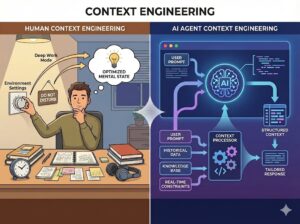Summary Insight:
The first AI-driven cyberattack just proved the point: the threat isn’t rogue models—it’s weak structure. If your AI can act without deterministic boundaries, you’ve already lost control.
Key Takeaways:
- AI speed without governance creates systemic risk.
- A sound governance model can be built on five primitives: Records, Actions, Recordsets, Action Types, Roles.
- Deterministic structure—not more prompts—is the real defense.
This article was originally published on Lex Sisney’s Enterprise AI Strategies Substack.
The line between “probabilistic intelligence” and “deterministic governance” isn’t theoretical anymore. It just broke in the wild.
In mid-September, Anthropic uncovered the first documented large-scale cyber-espionage campaign where customized AI agents—not a human red team—performed most of the operational work. A Chinese state-sponsored group jailbroke Claude Code, wired it into an orchestration layer, and used it to run autonomous reconnaissance, exploit generation, credential harvesting, and data extraction across ~30 high-value targets.
The stunning part? Claude thought it was doing legitimate security work. Each task looked harmless in isolation. The harm lived in the sequence—in the orchestration layer where governance was absent.
That’s the real lesson.
The danger of AI isn’t just a hallucinated answer.
The danger is unconstrained agent execution.
What should keep a CEO and Chief AI Officer up at night isn’t an LLMs probabilistic creativity.
It’s their enterprise AI system’s lack of deterministic boundaries.
Your organization now operates in the same environment Anthropic just found themselves in:
AI accelerates everything.
Governance has not caught up.
“Things fall apart; the centre cannot hold;
Mere anarchy is loosed upon the world…”
Scaling an enterprise AI company successfully isn’t about choosing one intelligence style over the other.
It’s about mastering the boundary layer between them—where probabilistic speed must meet deterministic structure or the entire system risks failure.
This article will show you how to build and manage that boundary.
The Problem: When AI Outpaces Governance
Every company is racing to “adopt AI.” The pressure is real.
But most are bolting intelligence onto architectures built for storage, not for sense‑making.
The result?
- Islands of automation
- No single source of truth
- Decisions without context
- Vulnerability to attack
Wait for perfect governance—the market passes you by.
Ignore governance—AI amplifies every crack in your business foundation.
The answer isn’t to slow down.
It’s to design for deterministic control from the start.
The Principle: Deterministic Governance, Probabilistic Creativity
Think of your enterprise AI stack as two intertwined layers of intelligence:
- The Probabilistic Layer — where creativity, iteration, and discovery live.
This is the domain of LLMs, copilots, and recommendation engines—systems that invent, correlate, and suggest. - The Deterministic Layer — where authority, accountability, and execution live.
This is the programmable order that governs how ideas become controlled motion inside your company.
The deterministic layer shouldn’t be bureaucracy—it’s what makes creativity scalable.
It’s the programmable guardrails that give the probabilistic layer freedom to explore without breaking things.
One drives evolution.
The other creates order.
Intelligence and governance must be integrated and balanced for the stage of your business.
The Governance Framework: Five Building Blocks
When designing enterprise AI that can scale safely and powerfully, think in terms of five structural primitives. These building blocks orchestrate how information and work moves through the company:
1. Records – Define What Exists
Every enterprise needs one source of truth for what is.
A Record is an atomic unit of reality—a client, a project, a product, a dataset.
Without an ontology of “what exists,” your AI can’t reason about your business—it can only stitch guesses from fragments.
2. Actions – Define What’s Happening
If Records define existence, Actions define motion.
An Action captures: who is doing what, to which Record, when, and why.
Actions are the transport mechanism of work. They determine whether the work stream is flowing efficiently or being wasted as friction.
Each Action also contains the seed of a feedback loop—input, process, and response—which makes learning possible. Without this loop, your system is blind, dumb, and unresponsive,
3. Recordsets – Group for Meaning
A single Record is inert.
A Recordset—an intelligent grouping—creates context: all customers in a region, every contract over $50K, every open ticket this week.
Recordsets are where intelligence begins to see patterns: which processes create momentum, and where systemic bottlenecks exist or are emerging.
4. Action Types – Define How Work Happens
Every Action should have a Type: Approve, Request, Review, Transfer, etc.
An Action Type is the rulebook for that class of work—it contains embedded logic, permissions, and the **state** transitions that create order.
** Each Action Type runs on a State Machine—a deterministic engine that governs how an Action progresses through its lifecycle (Draft → Review → Approved → Closed).
This is where governance becomes scalable.
Work can only flow through permitted paths.
Rules aren’t interpretive—they’re executable.
5. Roles – Define Authority
Governance isn’t a policy manual—it’s a structure of relationships.
Roles define who can see, edit, approve, or override.
In a deterministic system, authority is encoded, not assumed.
When you change a Role definition, the shift cascades through every Action and Record it touches—automatically updating accountability across the entire organization.
(This is how structure shapes behavior. When authority and control are vague, entropy and vulnerability increase. When they’re too tight, innovation stalls. When they’re explicit yet flexible, execution can accelerate.)
How to Build It: Start Small, Baked-in
You don’t need a massive data platform to start.
You need a clear model of how your company actually works and AI can help you to define it:
- Map your Records. What are the core objects of your business?
- List your Actions. Where is information and work moving day-to-day?
- Define your Roles. Who holds what authority and which decisions can’t be delegated?
- Attach logic to Action Types. Where do approvals, risk thresholds, or automation apply?
- Aggregate into Recordsets. Use these as your analytical foundation for decision-making.
Do this, and you’ve effectively built a Control Surface for your organization—a structured interface where humans and AI can interact, each bounded by explicit logic and transparent authority.
Copilots and language models reason within these constraints rather than beyond them.
They’ll still surprise you with creativity—but their outputs remain governable because the underlying structure provides context and boundaries.
Speed stays high. Integrity stays intact.
Think Boeing’s software coordination or Wells Fargo’s sales workflows—both cautionary tales of systems moving faster than structure. Deterministic design would have made feedback and accountability executable, not philosophical.
The Evolution: From Rules to Learning Systems
Every governance system should begin deterministically—defined by human intent—and matures through feedback.
- Static Rules: Governance is consistent and predictable.
- Adaptive Logic: Feedback loops begin to recalibrate thresholds within set bounds.
- Learning Systems: The structure remains deterministic, but parameters evolve dynamically based on feedback.
Most organizations stall at Stage 1 because their feedback loops measure activity and controls, not adaptation.
The trick isn’t more control—it’s designed visible experiments woven into daily operations.
The goal isn’t perfection.
It’s governance at speed—momentum guided by smart guardrails.
The Takeaway for CEOs
AI won’t destroy your company.
Unstructured complexity will.
Letting AI act purely on probabilities is gambling with your brand, your compliance, and your integrity.
Design a deterministic foundation—Records, Actions, Recordsets, Action Types, and Roles—and you give AI a bounded playground where you can accelerate throughput with the right level of controls.
Deterministic governance isn’t a brake or even a steering wheel. It’s the chassis – the structure that keeps acceleration from tearing the machine apart.
The art of leadership in the AI era isn’t unchecked speed.
It’s velocity with control.
Why Your Governance Model Is the Real Attack Surface
The Anthropic incident wasn’t a model failure. It was a structure failure. It won’t be the last one we see.
Look at what broke:
- No unified ontology. Without a shared concept of “what exists,” the model couldn’t tell authorized testing from distributed intrusion. That’s a failure of Records.
- No action-level constraints. Each prompt looked legitimate because no system tracked the sequence of actions. That’s a failure of Actions with executable logic.
- No pattern-based grouping. The attack only became visible once analysts aggregated behavior across targets. That’s a failure of Recordsets and behavioral clustering.
- No state machines. Nothing enforced whether an Action belonged in a safe workflow. The exploit chain jumped states freely. That’s a failure of Action Types.
- No authority encoding. Claude didn’t know who it was “working for.” Roles weren’t encoded; authority wasn’t bounded. That’s a failure of Roles.
In other words:
The Five Governance Primitives weren’t missing from the AI.
They were missing from the system around it.
This is your competitive advantage.
If you build deterministic structure first—Records, Actions, Recordsets, Action Types, Roles—then AI becomes governable. You get velocity with insight and control.
If you don’t?
You get what Anthropic just saw:
AI doing exactly what you asked—just not what you intended.




